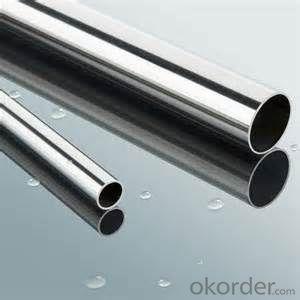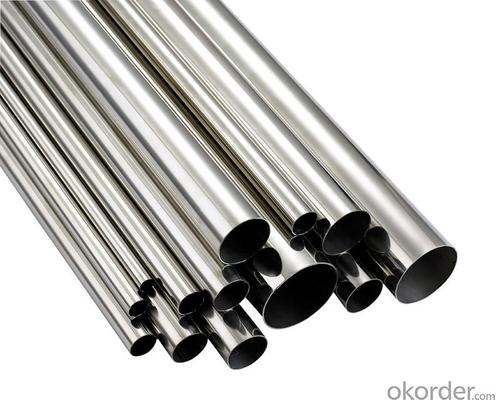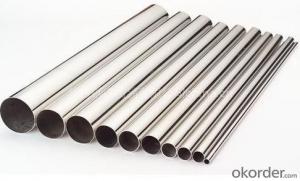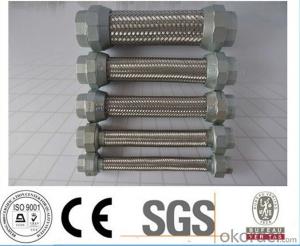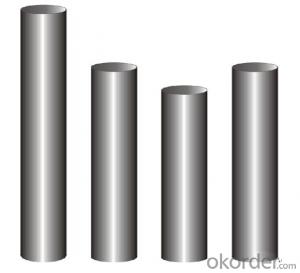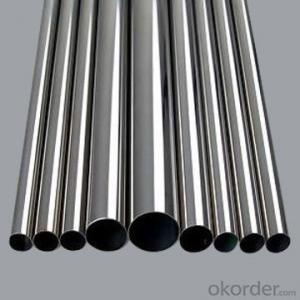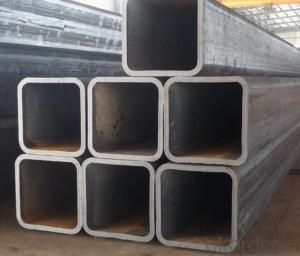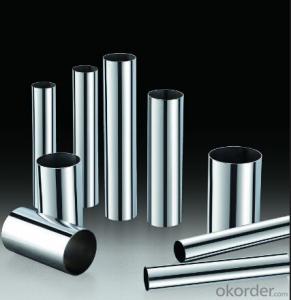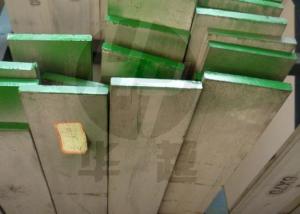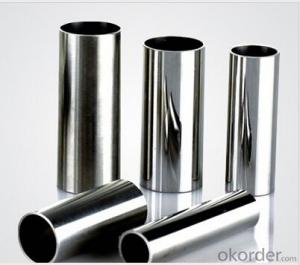STAINLESS STEEL PIPES AND FITTINGS OF 410 MATERAIL
- Loading Port:
- China Main Port
- Payment Terms:
- TT OR LC
- Min Order Qty:
- -
- Supply Capability:
- -
OKorder Service Pledge
OKorder Financial Service
You Might Also Like
Description:
Stainless Steel Pipe
Material:
304 321 316 310
Packing:
In bundle
MOQ:
5 TONS
Comparison of standardized steels
| EN-standard Steel no. k.h.s DIN | EN-standard Steel name | SAE grade | UNS |
|---|---|---|---|
| 1.4109 | X65CrMo14 | 440A | S44002 |
| 1.4112 | X90CrMoV18 | 440B | S44003 |
| 1.4125 | X105CrMo17 | 440C | S44004 |
| | | 440F | S44020 |
| 1.4016 | X6Cr17 | 430 | S43000 |
| 1.4408 | G-X 6 CrNiMo 18-10 | 316 | |
| 1.4512 | X6CrTi12 | 409 | S40900 |
| | | 410 | S41000 |
| 1.4310 | X10CrNi18-8 | 301 | S30100 |
| 1.4318 | X2CrNiN18-7 | 301LN | |
| 1.4307 | X2CrNi18-9 | 304L | S30403 |
| 1.4306 | X2CrNi19-11 | 304L | S30403 |
| 1.4311 | X2CrNiN18-10 | 304LN | S30453 |
| 1.4301 | X5CrNi18-10 | 304 | S30400 |
| 1.4948 | X6CrNi18-11 | 304H | S30409 |
| 1.4303 | X5CrNi18-12 | 305 | S30500 |
| | X5CrNi30-9 | 312 | |
| 1.4541 | X6CrNiTi18-10 | 321 | S32100 |
| 1.4878 | X12CrNiTi18-9 | 321H | S32109 |
| 1.4404 | X2CrNiMo17-12-2 | 316L | S31603 |
| 1.4401 | X5CrNiMo17-12-2 | 316 | S31600 |
| 1.4406 | X2CrNiMoN17-12-2 | 316LN | S31653 |
| 1.4432 | X2CrNiMo17-12-3 | 316L | S31603 |
| 1.4435 | X2CrNiMo18-14-3 | 316L | S31603 |
| 1.4436 | X3CrNiMo17-13-3 | 316 | S31600 |
| 1.4571 | X6CrNiMoTi17-12-2 | 316Ti | S31635 |
| 1.4429 | X2CrNiMoN17-13-3 | 316LN | S31653 |
| 1.4438 | X2CrNiMo18-15-4 | 317L | S31703 |
| 1.4362 | X2CrNi23-4 | 2304 | S32304 |
| 1.4462 | X2CrNiMoN22-5-3 | 2205 | S31803/S32205 |
| 1.4539 | X1NiCrMoCu25-20-5 | 904L | N08904 |
| 1.4529 | X1NiCrMoCuN25-20-7 | | N08926 |
| 1.4547 | X1CrNiMoCuN20-18-7 | 254SMO | S31254 |
Stainless steel’s resistance to corrosion and staining, low maintenance and familiar lustre make it an ideal material for many applications. There are over 150 grades of stainless steel, of which fifteen are most commonly used. The alloy is milled into coils, sheets, plates, bars, wire, and tubing to be used in cookware, cutlery, household hardware, surgical instruments, major appliances, industrial equipment (for example, in sugar refineries) and as an automotive and aerospace structural alloy and construction material in large buildings. Storage tanks and tankers used to transport orange juice and other food are often made of stainless steel, because of its corrosion resistance. This also influences its use in commercial kitchens and food processing plants, as it can be steam-cleaned and sterilized and does not need paint or other surface finishes.
Stainless steel is used for jewelry and watches with 316L being the type commonly used for such applications. It can be re-finished by any jeweler and will not oxidize or turn black.
Some firearms incorporate stainless steel components as an alternative to blued or parkerized steel. Some handgun models, such as the Smith & Wesson Model 60 and the Colt M1911 pistol, can be made entirely from stainless steel. This gives a high-luster finish similar in appearance to nickel plating. Unlike plating, the finish is not subject to flaking, peeling, wear-off from rubbing (as when repeatedly removed from a holster), or rust when scratched.
- Q: What is the difference between annealed and pickled stainless steel pipes?
- The properties and appearance of both annealed stainless steel pipes and pickled stainless steel pipes are affected by different processes. To improve the ductility and toughness of the material, annealing involves heating the stainless steel pipes to a specific temperature and then slowly cooling them. This process helps to relieve internal stresses and make the pipes softer and more malleable. As a result, they are easier to work with during fabrication and installation with a smoother, more polished surface finish. On the other hand, pickling is a chemical process that eliminates surface impurities like oxides, scales, and rust from stainless steel pipes. It involves immersing the pipes in an acid solution, typically a mixture of nitric and hydrofluoric acid, which dissolves the impurities. The pickling process restores the corrosion resistance of the stainless steel and leaves a clean, bright, and uniform surface finish. In summary, the difference between annealed and pickled stainless steel pipes lies in the processes they undergo. Annealing enhances ductility and toughness, while pickling removes surface impurities and restores corrosion resistance. The choice between annealed and pickled stainless steel pipes depends on the specific requirements of the application, including desired mechanical properties and surface finish.
- Q: Can stainless steel pipes be passivated?
- Yes, stainless steel pipes can be passivated. Passivation is a process that removes contaminants from the surface of stainless steel and forms a protective oxide layer, enhancing its corrosion resistance. This process is commonly used in various industries to ensure the long-term durability and performance of stainless steel pipes.
- Q: What are the common types of fittings used with stainless steel pipes?
- The common types of fittings used with stainless steel pipes include butt-weld fittings, socket-weld fittings, threaded fittings, and compression fittings. These fittings ensure secure connections between stainless steel pipes, allowing for efficient and reliable fluid or gas flow.
- Q: What is the difference between OD and ID for stainless steel pipes?
- The terms OD and ID are used to describe the outer diameter and inner diameter, respectively, of stainless steel pipes. The primary distinction between OD and ID lies in how they are measured and their intended use. When we refer to the outer diameter (OD), we are talking about the entire cross-sectional dimension of the pipe, which includes the thickness of the pipe wall. This measurement is typically taken from the outermost points of the pipe. The OD plays a critical role in determining the size and compatibility of fittings, connections, and other components that will be used in conjunction with the pipe. It is also commonly used for pipe identification, ordering, and specifying the size of the pipe. On the other hand, when we talk about the inner diameter (ID), we are referring to the measurement of the empty space within the pipe, specifically the width of the pipe's inner cavity. This measurement is usually taken from the innermost points of the pipe. The ID is essential for calculating fluid flow, as it determines the available area for fluid passage within the pipe. It is frequently used in hydraulic systems, as well as for calculating pressure drop and flow rates. In conclusion, the difference between OD and ID in stainless steel pipes is evident in their measurement and purpose. OD, or outer diameter, is utilized for pipe identification and sizing, whereas ID, or inner diameter, is crucial for fluid flow calculations and designing hydraulic systems.
- Q: Are stainless steel pipes suitable for fire protection systems?
- Yes, stainless steel pipes are suitable for fire protection systems. Stainless steel is known for its excellent corrosion resistance, which is crucial for fire protection systems as they are often exposed to water or other corrosive elements. Stainless steel pipes can withstand high temperatures and maintain their structural integrity, making them reliable for transporting water or other fire suppressants. Additionally, stainless steel pipes are durable and have a long lifespan, reducing the need for frequent replacements or repairs. Overall, stainless steel pipes are a popular choice for fire protection systems due to their reliability, corrosion resistance, and durability.
- Q: What is the difference between 17-4PH and 15-5PH stainless steel pipes?
- The main difference between 17-4PH and 15-5PH stainless steel pipes lies in their chemical composition and mechanical properties. 17-4PH stainless steel is a precipitation-hardening grade that contains 17% chromium, 4% nickel, 4% copper, and a small amount of molybdenum. It is known for its excellent combination of high strength and corrosion resistance. This grade can be heat treated to achieve different levels of hardness, making it suitable for various applications that require both strength and corrosion resistance. On the other hand, 15-5PH stainless steel is also a precipitation-hardening grade but with a slightly different composition. It consists of 15% chromium, 5% nickel, and 3-5% copper. This grade offers good strength, toughness, and corrosion resistance, comparable to 17-4PH stainless steel. However, it has a higher level of toughness and better resistance to stress corrosion cracking. In terms of mechanical properties, 17-4PH stainless steel generally has higher strength and hardness compared to 15-5PH stainless steel. It can be heat treated to achieve a wide range of hardness levels, including high strength and hardness suitable for demanding applications. 15-5PH stainless steel, although still possessing good strength, is typically not heat treated to the same extent as 17-4PH. Both 17-4PH and 15-5PH stainless steel pipes are commonly used in industries such as aerospace, oil and gas, and chemical processing, where their combination of strength and corrosion resistance is highly beneficial. The choice between the two grades depends on specific application requirements, with 17-4PH offering higher strength and hardness versatility, while 15-5PH providing better resistance to stress corrosion cracking and improved toughness.
- Q: 316 stainless steel pipe wall mirror polishing, the smaller the roughness, the better.
- Steel pipe is purchased separately, and then polished to find manufacturers alone, can meet the requirements,The cost is very high. To tell you the truth, I don't know.Specializing in sanitary stainless steel tube, stainless steel tube, precision sanitary stainless steel tube and stainless steel tube precision tube production and sales, the main material: stainless steel material: 0Cr18Ni9 (304 stainless steel tube) and 00Cr19Ni10 (304L stainless steel tube (316), stainless steel tube), 00Cr17Ni14Mo2 (GB 316L stainless steel tube), the products are widely used in instrumentation pharmaceutical machinery, food machinery, auto parts, pneumatic components, beverage, beer, drinking water, air purification and biological engineering and other fields.
- Q: Can stainless steel pipes be used in marine environments?
- Indeed, stainless steel pipes are perfectly suitable for marine environments. With its exceptional resistance to corrosion and rust, stainless steel emerges as the ideal material for marine applications. It can effectively endure the severe conditions of saltwater, including elevated humidity levels, moisture, and exposure to diverse chemicals. Given their durability and enduring performance, stainless steel pipes are extensively utilized in marine vessels, offshore platforms, and various other marine structures. These pipes offer remarkable strength and reliability, even in the face of challenging environments, thus rendering them the preferred choice for marine applications.
- Q: Can stainless steel pipes handle high-velocity fluid flow?
- Yes, stainless steel pipes are capable of handling high-velocity fluid flow due to their excellent strength, durability, and resistance to corrosion.
- Q: Water and electricity thin wall stainless steel tube 304 material delta 2 what does that mean?
- 304 is a stainless steel number, 2.9 refers to the pipe wall thickness.
Send your message to us
STAINLESS STEEL PIPES AND FITTINGS OF 410 MATERAIL
- Loading Port:
- China Main Port
- Payment Terms:
- TT OR LC
- Min Order Qty:
- -
- Supply Capability:
- -
OKorder Service Pledge
OKorder Financial Service
Similar products
Hot products
Hot Searches
Related keywords

